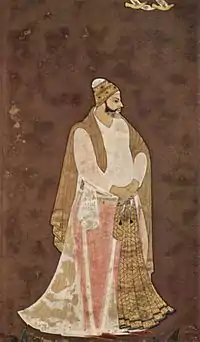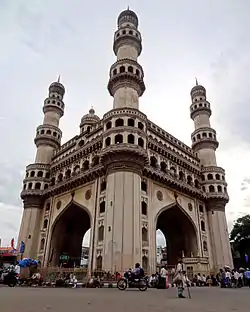Muhammad Quli Qutb Shah
Muhammad Quli Qutb Shah (4 April 1565 – 11 January 1612) was the fifth sultan of the Qutb Shahi dynasty of Golkonda and founded the city of Hyderabad,[2] in South-central India and built its architectural centerpiece, the Charminar. He was an able administrator and his reign is considered one of the high points of the Qutb Shahi dynasty. He ascended to the throne in 1580 at the age of 15 and ruled for 31 years.[3]
| Muhammad Quli Qutub Shah | |
|---|---|
| Fifth Sultan of Qutb Shahi dynasty | |
 | |
| 5th Sultan of the Qutb Shahi Sultanate of Golconda | |
| Reign | 1580–1612[1] |
| Coronation | Unknown |
| Predecessor | Ibrahim Quli Qutb Shah |
| Successor | Sultan Muhammad Qutb Shah |
| Born | 4 April 1565 Golkonda, Golconda Sultanate (now in Telangana, India) |
| Died | 11 January 1612 (aged 46) Daulat Khan-e-Ali Palace, Hyderabad (now in Telangana, India) |
| Spouse | Bhagmati |
| Issue | Hayat Bakshi Begum (wife of Sultan Muhammad Qutb Shah) |
| House | Qutb Shahi dynasty |
| Father | Ibrahim Quli Qutb Shah |
| Mother | Bhagirathi |
| Religion | Shia Islam |

Birth, early life and personal life
Muhammad Quli Qutub Shah was the third son of Ibrahim Quli Qutb Shah Wali and Hindu Mother Bhagirathi.[4] He was an accomplished poet and wrote his poetry in Persian, Telugu and Urdu.[5] As the first author in the Urdu language, he composed his verses in the Persian diwan style, and his poems consisted of verses relating to a single topic, gazal-i musalsal.[5] Muhammad Quli's Kulliyat comprised 1800 pages, over half were gazals, qasidas on one hundred pages, while the rest contained over 300 pages of matnawi and marsiyas.[5]
Reign of Muhammad Quli Qutb

Muhammad Quli Qutb Shah succeeded his father Ibrahim Quli Qutb Shah in the year 1580 at the age of 15 years.[3] His rule lasted for 31 years, his contemporaries were Akbar the Great, Jagat Guru and Ibrahim Adil Shah. He faced minor rebellions on eastern and western fronts during the initial years of his rule. He lead the troops himself and defeated Ali Khan Loor and Yashwant Raj.[6]
In 1592 further disturbance was created by Shah Saheb for ascending the throne. During this time he sent Aitbar Khan with a large troop and he defeated Shah Saheb. Amidst the chaos Muhammad Quli was still able to patronage art and establish the city of Hyderabad.[6] His reign is considered the high point of Qutb Shahi dynasty.[3]
City of Hyderabad
From the time of his father Ibrahim Quli Qutb Shah, there was a high influx of populace into the city of Golkonda, which lead to over-crowding and unhygienic conditions. This created the need for an extension or new city. [3] The construction of Hyderabad was initiated in 1591, on the southern bank of the River Musi. Before construction he prayed by reciting the following couplet for the welfare of the city "Make my city full of people, like you keep the river full of fish."[6]
There is a degree of folklore associated with selection of the land for the new city of Hyderabad. It is said that once the King was coming back from a hunt and he crossed the bridge across River Musi and arrived at the flat land which pleased him. However, Muhammad Quli must have been aware of the presence of this land and the story is a romanticised version.[3]
The city was planned in a gridiron manner with charminar in the centre and other important palaces and administrative buildings along the surrounding axes. Other important buildings which were constructed in the following years are Darulshafa, Mecca Masjid, Badshahi Ashurkhana and several palaces which have been demolished over the years.[6]
Muhammad Quli also planned several gardens throughout the city, which came to be known as "Garden City" and the same is mentioned in several travellers' accounts. Rafi-uddin Shirazi mention in Tazkiratul Muluk that the entire city looked likes a vast garden.[6]
Patronage of Art and Literature
Muhammad Quli was a patron of poetry, paintings, calligraphy and architecture. Major scripts used in this period are Nastaliq, Naksh, Kufi, Tughra and Sulus. A unique inscription is on Mecca Masjid in Nastaliq script, a script not known anywhere else in the Deccan region. Another inscription in the same mosque is a verse of the Quran carved in Naksh style.[6][7]
Poetry was another forte of Muhammad Quli and he is considered one of the first poets to write in the Dakhni language. He wrote in a wide range of genres from religious to romantic to profane. [3] One of his works is the Diwan, and the original manuscript is exhibited at Salar Jung Museum, Hyderabad.[7] Apart from Dakhni-Urdu, he also wrote in Telugu. Born and brought up in Hyderabad, he was fluent in Telugu as well.[3] His poetry has been compiled into a volume entitled "Kulliyat-e-Quli Qutub Shah." He was the first Saheb-e-dewan Urdu poet[8]
Physicians who wrote Persian language books on Unani medicine during his reign include Mir Momin (Ikhtiyarat-i Qutub Shahi), Shamsuddin Ali Husain al-Jurjani (Tazkirat-i Kahhalin), Hakim Shamsuddin bin Nuruddin (Zubdat-ul Hukama), Abdullah Tabib (Tibb-i Farid), Taqiuddin Muhammad bin Sadruddin Ali (Mizan-ul Tabai'), Nizamuddin Ahmad Gilani (Majmu'a-i Hakim-ul mulk), and Ismai'l bin Ibrahim Tabrezi (Tazkirat-ul Hukama).[9]
Notes
- Sen, Sailendra (2013). A Textbook of Medieval Indian History. Primus Books. p. 118. ISBN 978-9-38060-734-4.
- Pillai, Manu S. (15 November 2018). "Opinion: A Hyderabadi conundrum". Mint.
- "Muhammad-Quli Qutb Shah: Founder of Haidarabad". INDIAN CULTURE. Retrieved 4 April 2023.
- Luther, Narendra (1991). Prince;Poet;Lover;Builder: Mohd. Quli Qutb Shah - The founder of Hyderabad. Publications Division Ministry of Information & Broadcasting. ISBN 9788123023151.
- Schimmel, Annemarie (1975). Classical Urdu Literature from the Beginning to Iqbāl. Otto Harrassowitz. p. 143.
- K̲h̲ān̲, Masʻūd Ḥusain (1996). Mohammad Quli Qutb Shah. Sahitya Akademi. ISBN 978-81-260-0233-7.
- Weinstein, Laura (2014). "Variations On A Persian Theme". The Visual World of Muslim India. doi:10.5040/9780755603831.ch-008. ISBN 978-0-7556-0561-3.
- "Quli Qutub Shah remembered on his 400th death anniversary". The Siasat Daily. 14 January 2012. Archived from the original on 18 January 2012.
- Hussain, Syed Ejaz (2015). "Rise and Decline of Surgery in Indigenous Medicine with Emphasis on Unani-tibb". In Saha, Mohit; Hussain, Syed Ejaz (eds.). India's Indigenous Medical Systems: A Cross-disciplinary Approach. Primus. p. 68. ISBN 9789380607627.
References
- Sangaychay Mala by Gajanan Pole
- Prime Ministers of Qutubshhs by Sri Bhopal Rao
- Luther, Narendra (1991). Prince, Poet, Lover, Builder: Muhammad Quli Qutb Shah, The Founder of Hyderabad (PDF). Publications Division Ministry of Information & Broadcasting. ISBN 9788123023151.
- Sherwani, Haroon Khan (1967). Muhammad-Quli Qutb Shah, founder of Haidarabad. Asia Publishing House.
- Books on Muhammad Quli Qutb Shah
- Chopra, R.M., The Rise, Growth And Decline of Indo-Persian Literature, Iran Culture House, New Delhi, 2012.
- https://indianculture.gov.in/rarebooks/landmarks-deccan-comprehensive-guide-archaeological-remains-city-and-suburbs-hyderabad
Further reading
- Luther, Narendra Prince, Poet, Lover, Builder: Muhammad Quli Qutb Shah, The Founder of Hyderabad 1991
